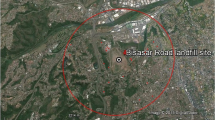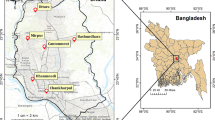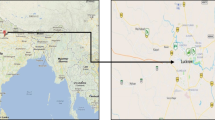Abstract
Real-time particulate matters (PM1, PM2.5, PM4, PM7, PM10, and TSP) with AEROCET 531S (USA), gaseous pollutants (NO2 and TVOC) with Aeroquel 500 gas sampler (NZ) were measured from the indoor air of houses at four residential locations in Dhaka, Bangladesh. PM10 samples were collected on quartz filters with a dual channel dust sampler (IPM-FDS 2510, India) for selected trace metal determination from five houses of Dhaka. Respiratory function of the occupants was assessed by using a peak expiratory flow meter (Rossmax PF 120). Mean PM1, PM2.5, and PM10 concentrations were 46.1 ± 13.4, 76.0 ± 16.2, and 203.9 ± 44.8 μg m−3, respectively. Higher enrichment factors of Pb, Zn, and Ni were found for traffic, industrial, and constructional activities. The correlation between indoor and outdoor PM2.5 (R2 = 0.42) and ratios (I/O < 1) suggesting indoor air was effected by outdoor air. The concentration of NO2 (0.076 ± 0.007 ppm) and TVOC (90.0 ± 46.0 ppm) was found above than other studies. The average total hazard ratio (THR) in Dhaka was 9.06 and has the highest exposure to air pollutants (PM2.5, PM10, NO2) in Khilkhet (THR 10.1) residents. A negative association between ultra-fine particles (PM1) and peak flow rate measurements of the residents living in these houses indicates that inhalations of ultra-fine particles has great influence on the reduced lung efficiency.






Similar content being viewed by others
References
Abrar A, Sundas W, Perveen F, Habib M (2014) Air quality monitoring of some gaseous pollutants at selected points in Gullberg II, Lahore, Pakistan. Int Res J Env Sci 3:38–47
Abt E, Suh HH, Allen G, Koutrakis P (2000) Characterization of indoor particle sources: a study conducted in the metropolitan Boston area. Environ Health Perspect 108:35–44
Ahmed M, Hossain A, Akther T, Shohel M, Salam A (2018) Chemical composition and source identification of fog water at an indo-Gangetic plain (IGP) outflow location (coastal Bhola Island), Bangladesh. J Environ Pollut Manag 1:104
Arbex MA, Martins LC, Pereira LAA, Negrini F, Cardoso AA, Melchert WR, Arbex RF, Saldiva PHN, Zanobetti A, Braga ALF (2007) Indoor NO2 air pollution and lung function of professional cooks. Braz J Med Biol Res 40:527–534
Begum AB, Biswas SK (2009) Characterization and apportionment of sources of indoor air particulate matter of aecd campus, Dhaka. J Bangladesh Acad Sci 33:25–36
Blondeau P, Iordache V, Poupard O, Genin D, Allard F (2005) Relationship between outdoor and indoor air quality in eight French schools. Indoor Air 15:2–12
Brown JS, Gordon T, Price O, Asgharian B (2013) Thoracic and respirable particle definitions for human health risk assessment. Fibre Toxicol 10:12
Chan CC, Chen BY, Cheng T-J, Guo YL (2015) Effects of particulate air pollution and ozone on lung function in non-asthmatic children. Environ Res 137:40–48
Chen C, Zhao B (2011) Review of relationship between indoor and outdoor particles: I/O ratio, infiltration factor and penetration factor. Atmos Environ 45:275–288
Colbeck I, Nasir ZA, Ali Z (2010) Characteristics of indoor/outdoor particulate pollution in urban and rural residential environment of Pakistan. Indoor Air 20:40–51
Datta A, Suresh R, Gupta A, Singh D, Kulshrestha P (2017) Indoor air quality of non-residential urban buildings in Delhi, India. Int J Sust Built Environ 6:412–420
Dherani M, Pope D, Mascarenhas M, Smith KR, Weber M, Bruce N (2008) Indoor air pollution from unprocessed solid fuel use and pneumonia risk in children aged under five years: a systematic review and meta-analysis. Bull World Health Organ 86:390–398
Dockery DW, Pope CA 3rd, Xu X, Spengler JD, Ware JH, Fay ME, Ferris BG Jr, Speizer FE (1993) An association between air pollution and mortality in six U.S. cities. N Engl J Med 329:1753–1759
Feng CT, Kirk RS, Nuntavarn V-V, Bart DO, Lauraine GC, Nipapun K (2000) Indoor/outdoor PM10 and PM2.5 in Bangkok, Thailand. J Expo Anal Environ Epidomial 10:15–26
Fung YS, Wong LWY (1995) Apportionment of air pollution sources by receptor models in Hong Kong. Atmos Environ 29:2041–2048
Gennaro de G, Farella G, Marzocca A, Mazzone A, Tutino M (2013) Indoor and outdoor monitoring of volatile organic compounds in school buildings: indicators based on health risk assessment to single out critical issues. Int J Environ Res Public Health 10:6273–6291
Gurley ES, Salje H, Homaira N, Ram PK, Haque R, Petri WA Jr, Bresee J, Moss WJ, Luby SP, Breysse P, Azziz-Baumgartner E (2013) Seasonal concentrations and determinants of indoor particulate matter in a low-income community in Dhaka. Bangladesh Environ Res 121:11–16
Haller L, Claiborn C, Larson T, Koenig J, Norris G, Edgar R (1999) Airborne particulate matter size distributions in an arid urban area. J Air Waste Manag Assoc 49:161–168
Harrison RM, Smith DJT, Pio CA, Castro LM (1996) Source apportionment of atmospheric polycyclic aromatic hydrocarbons collected from an urban location in Birmingham, UK. Environ Sci Technol 30:825–832
Jodeh S, Hasan AR, Amarah J, Father J, Salghi R, Lgaz H, Jodeh W (2018) Indoor and outdoor air quality analysis for the city of Nablus in Palestine: seasonal trends of PM10, PM5.0, PM2.5 and PM1.0 of residential homes. Air Qual Atmos Health 11:229–237
Jones NC, Thornton CA, Mark D, Harrison RM (2000) Indoor/outdoor relationships of particulate matter in domestic homes with roadside, urban and rural locations. Atmos Environ 34:2603–2612
Khalequzzaman M, Kamijima M, Sakai K, Chowdhury NA, Hamajima N, Nakajima T (2007) Indoor air pollution and its impact on children under five years old in Bangladesh. Indoor Air 17:297–304
Klepeis NE, Nelson WC, Ott WR, Robinson JP, Tsang AM, Switzer P, Behar JV, Hern SC, Engelmann WH (2001) The National Human Activity Pattern Survey (NHAPS): a resource for assessing exposure to environmental pollutants. J Expo Sci Environ Epidemiol 11:231–252
Koenig JQ, Mar TF, Allen RW, Jansen K, Lumley T, Sullivan JH, Trenga CA, Larson T, Liu LJ (2005) Pulmonary effects of indoor- and outdoor-generated particles in children with asthma. Environ Health Perspect 113:499–503
Kulshreshtha P, Khare M (2010) A comparative study of indoor air pollution and its respiratory impacts in Delhi, India. WIT Trans Ecol Environ 136:287–296
Kulshreshtha P, Khare M (2011) Indoor exploratory analysis of gaseous pollutants and respirable particulate matter at residential homes of Delhi, India. Atmos Pollut Res 2:337–350
Laidlaw MAS, Zahran S, Mielke HW, Taylor MP, Filippelli GM (2012) Re-suspension of lead contaminated urban soil as a dominant source of atmospheric lead in Birmingham, Chicago, Detroit and Pittsburgh, USA. Atmos Environ 49:302–310
Landrigan J, Richard F, Nereus BE, Acosta JR, Olusoji A, Arnold R, Niladri, Bertollini R (2017) The lancet commission on pollution and health. Lancet 391:462–512
Leung D (2015) Outdoor-indoor air pollution in urban environment: challenges and opportunity. Front Environ Sci 2:1–7
Lin GZ, Peng RF, Chen Q, Wu ZG, Du L (2009) Lead in housing paints: an exposure source still not taken seriously for children lead poisoning in China. Environ Res 109:1–5
Liu HY, Dunea D, Iordache S, Pohoata A (2018) A review of airborne particulate matter effects on young Children’s respiratory symptoms and diseases. Atmosphere 9:150
Massey D, Kulshrestha A, Masih J, Taneja A (2012) Seasonal trends of PM10, PM5.0, PM2.5 & PM1.0 in indoor and outdoor environments of residential homes located in north-Central India. Build Environ 47:223–231
Mohammadyan M, Ashmore M, Shabankhani B (2008) Indoor PM2.5 concentrations in the office, café, and home. J Occup Environ Hyg 2:57–62
Nahar M, Khan MH, Ahmad SA (2016) Indoor air pollutants and respiratory problems among Dhaka City dwellers. Arch Community Med Public Health 2:32–36
Nakai S, Tamura K (2008) Relationship between indoor and outdoor particulate matter concentrations in Japan. Asian J Atmos Environ 2:68–74
Oosterlee A, Drijver M, Lebret E, Brunekreef B (1996) Chronic respiratory symptoms in children and adults living along streets with high traffic density. Occup Environ Med 53:241–247
Pace TG, Watson JG (1987) Protocol for applying and validating the CMB model. Report No. EPA 450/4-87-010. US Environmental Protection Agency, Research Triangle Park, NC
Perez-Padilla R, Schilmann A, Riojas-Rodriguez H (2010) Respiratory health effects of indoor air pollution. Int J Tuberc Lung Dis 14:1079–1086
Ram PK, Dutt D, Silk BJ, Doshi S, Rudra CB, Abedin J, Goswami D, Fry AM, Brooks WA, Luby SP, Cohen AL (2014) Household air quality risk factors associated with childhood pneumonia in urban Dhaka, Bangladesh. Am J Trop Med Hyg 90:968–975
Salam A, Mamoon HA, Ullah MB, Ullah SM (2012) Measurement of the atmospheric aerosol particle size distribution in a highly polluted mega-city in Southeast Asia (Dhaka-Bangladesh). Atmos Environ 59:338–343
Shohel M, Simol HA, Reid E, Reid JS, Salam A (2017) Dew water chemical composition and source characterization in the IGP outflow location (coastal Bhola, Bangladesh). Air Qual Atmos Health 10:981–990
Smith K (2003) Fuel combustion, air pollution exposure, and health: the situation in develo** countries. Annu Rev Energy Environ 18:529–566
Sörme L, Bergbäck B, Lohm U (2001) Goods in the anthroposphere as a metal emissions source e a case study of Stockholm, Sweden. Water Air Soil Pollut 1:213–227
Srithawirat T, Latif MT (2015) Concentration of selected heavy metals in the surface dust of residential buildings in Phitsanulok, Thailand. Environ Earth Sci 74:2701–2706
Stazi F, Naspi F, Ulpiani G, Perna CD (2017) Indoor air quality and thermal comfort optimization in class rooms develo** an automatic system for windows opening and closing. Energy Build 139:732–746
United States Environment Protection Agency (US EPA) (2011). The Screening Level (RSL) Tables (Last updated June 2011)
Uzoigwe JC, Prum T, Bresnahan E, Garelnabi M (2013) The emerging role of outdoor and indoor air pollution in cardiovascular disease. N Am J Med Sci 5:445–453
Valavanidis A, Fiotakis K, Vlachogianni T (2008) Airborne particulate matter and human health: toxicological assessment and importance of size and composition of particles for oxidative damage and carcinogenic mechanisms. J Environ Sci Health C Environ Carcinog Ecotoxicol Rev 26:339–362
Wagdi D, Tarabieh K, Zeid MNA (2018) Indoor air quality index for preoccupancy assessment. Air Qual Atmos Health 11:445–458
Wallace L (1996) Indoor particles: a review. J Air Waste Manag Assoc 46:98–126
Wolkoff P (1995) Volatile organic compounds – sources, measurements, emissions and the impact on indoor air quality. Indoor Air 3:1–73
Wolkoff P, Johnsen CR, Franck C, Wilhardt P, Albrechtsen O (1992) A study of human reactions to office machines in a climatic chamber. J Expo Anal Environ Epidemiol SupplI(7):1–97
World Health Organization (2011) Methods for monitoring indoor air quality in schools: report of a meeting, Bonn, Germany, 4–5 April 2011. WHO Regional Office for Europe. http://www.who.int/iris/handle/10665/108596. Accessed 24 Dec 2018
World Health Organizations (WHO) (2018) Household air pollution and health (link: http://www.who.int/news-room/fact-sheets/detail/household-air-pollution-and-health). Accessed 24 Dec 2018
Yassin M, AlThaqeb BEY, Al-Mutiri EAE (2012) Assessment of indoor PM2.5 in different residential environments. Atmos Environ 56:65–68
Zahran S, Laidlaw MA, McElmurry SP, Filippelli GM, Taylor M (2013) Linking source and effect: resuspended soil lead, air lead, and children’s blood lead levels in Detroit, Michigan. Environ Sci Technol 47:2839–2845
Zhang Q, Jiang X, Tong D, Davis SJ, Zhao H, Geng G, Feng T, Zheng B, Lu Z, Streets DG, Ni R, Brauer M, van Donkelaar A, Martin RV, Huo H, Liu Z, Pan D, Kan H, Yan Y, Lin J, He K, Guan D (2017) Transboundary health impacts of transported global air pollution and international trade. Nature 543:705–709
Acknowledgements
Authors acknowledge the owner and residents of the houses who were hel** during sampling and also participating in the lung function test experiments. Centre for Advanced Research in Sciences (CARS) for hel** with trace metal analysis.
Funding
Authors acknowledge the financial support of the Ministry of Education, The Government Republic of Bangladesh (Project no.: PS 14138).
Author information
Authors and Affiliations
Corresponding author
Additional information
Responsible editor: Constantini Samara
Publisher’s Note
Springer Nature remains neutral with regard to jurisdictional claims in published maps and institutional affiliations.
Rights and permissions
About this article
Cite this article
Akther, T., Ahmed, M., Shohel, M. et al. Particulate matters and gaseous pollutants in indoor environment and Association of ultra-fine particulate matters (PM1) with lung function. Environ Sci Pollut Res 26, 5475–5484 (2019). https://doi.org/10.1007/s11356-018-4043-2
Received:
Accepted:
Published:
Issue Date:
DOI: https://doi.org/10.1007/s11356-018-4043-2




